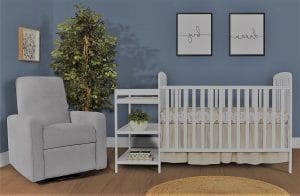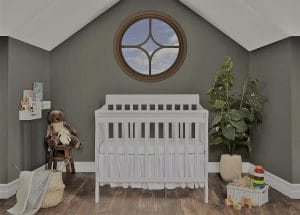For hundreds of years, the crib has been the best sleeping arrangement for infants. Little cribs and standard-sized cribs are often used equally, yet each has its role in a new family’s life.
They may include wheels to make it easier to move about, but they look and operate in much the same manner as for regular cribs. Sometimes, much like ordinary cribs, they may change to child beds or twin beds as your kid develops.
A small crib is a tiny variation of a complete crib that can be useful in a variety of settings. Its shape and size have altered throughout time, but really, its essential design has not.
These days, mini cribs are gaining popularity since they take up far less room than standard cribs. The main difference between tiny and full-sized cribs is size, as well as how sizes are standardized.
What is a full-size crib?
A normal size crib, which is larger and has more amenities, is designed to be permanently installed in your house. They can have tables or sections, besides a variety of designs.
The majority of full-size cribs change to child beds and then to child beds, ensuring that they endure for a lengthy time. A normal crib mattress’s normal measurements are 71.52 x 132.08cm, with a thickness of 12.7 to 15.24cm.
A normal crib’s size and dimensions tend to follow standardization, but they might vary significantly depending on the kind of model. The size fluctuation is generally less than 0.635cm.
The major utilities of the full-sized crib
The main purpose of the full-size crib is to reduce the risk of injuries and deaths caused by crib falls or traps as a result of a component breakdown, deposit-taking, or incomplete crib maintenance or assembly.

Pros
- The large size is suitable for babies aged two and above.
- More storage and features
- As your child develops, it may be utilized as a crib.
- The sturdy structure allows for larger babies to be carried.
Cons
- It’s pricier than a tiny crib.
- It takes up more room and isn’t portable.
What is a mini crib?
In a word, a micro crib is shorter, less costly, and better suited to houses with limited space.
A small crib is an ideal solution for new moms who have shorted periods, space, or funds to care for their newborns. It seems you’re placed in a new tiny home, or tiny home traveling for vacation, and you need a crib for your infant to take care of your family with the help of transition. In this case, a tiny crib is excellent.
Small cribs are often a terrific addition to multi-room houses, your infant may want alternative sleeping arrangements.
A tiny crib is suitable for children under the age of two who weigh under forty-five lbs. To prevent your infant from climbing over them, they have wide and horizontal addition sides. They also include a variety of options that you will be liked.
Most tiny cribs include caster wheels to make moving them around simpler. Mini crib linens and mattresses are not identical. That implies you’ll need to locate a sheet brand that is adjusted and stay with it for size purposes.
Above all, you need not purchase a tiny crib that has not been safety inspected and authorized. Before buying a product, look for reviews of a certain model online. Also, thoroughly check the small crib’s structure before committing your baby to it for the night.
Because a newborn will have a lot of horrible accidents, you’ll have to modification of many children’s bedding. It’s a moral idea to have additional sheets on hand. As a result, it is critical not to hurry out and get alternatives that are improper size.
The majority of micro-cribs are collapsible, portable, and cost less than an entire crib. A tiny crib mattress’s usual measurements are 24 by 38 inches, with a thickness of 1 to 4 inches. Keep in mind, however, that not all small crib sizes are the same.
A close-up of a miniature crib, Because the size and measurements of a tiny crib aren’t standardized and differ by manufacturer and model, you’ll need to make sure you get the right sheets for your mattress. For babies under the age of two, a tiny crib is an ideal option.
The major utilities of mini cribs.
It is the best performance to look after your child. It is also cheap and the best on your budget. Adjusted two cribs into a single room. Adjusted a crib into an elder child’s room.

Pros
- It’s easier to transport, pack, and reposition.
- Smaller dimensions are easier to fit into small spaces, making them ideal for babies.
- Because of their foldable shape, mini cribs are easy to store.
- Larger choices are more costly.
Cons
- Your child may outgrow it sooner rather than later.
- Later on, a bigger crib will be required.
Mini crib vs Full-Size crib
| Mini cribs | Full-size cribs |
| For simple mobility and room switching, mini cribs with tires on the base are ideal. | Wheels are available on full-sized cribs, although they are uncommon. You’ll have a higher chance of discovering this function on non-standard cribs if it’s relevant to you. |
| Mini cribs have no sheets and bedding | Full-size cribs have sheets and bedding |
| As the mini cribs are smaller, so is weightless. | Full-size cribs are bigger, so they weigh too much. |
| A tiny crib will almost certainly cost less than a normal crib. | It’s pricier than a tiny crib.
|
Benefits of mini crib
Mini cribs are significantly less costly than regular cribs. smaller! This is the most evident. They require less space, which is useful.
Greater portability: Many small cribs include wheels, which make it easy to move from room to room or to slide the cribs out another way to momentarily free up space.
Since they are smaller, mini cribs are significantly simpler to move and construct than full-sized or conventional cribs.
FAQ
When to use a baby crib?
The following are some of the most common uses for a small crib:
- In the case of tiny nurseries.
- If you’re on a shoestring budget.
- Multiple cribs for babies in a single room.
- Putting a crib in the room of an older kid.
- Having a sleeping space for the infant at a grandparent’s residence.
- Simply put, tiny cribs are small parts of full-sized cribs.
How extended can a baby stay in a small crib?
Have you ever wondered, “Can a baby remain in a small crib for a long time?” The first year of a child’s life is filled with rapid growth. We all need a crib that can grow with our children while still keeping them safe and protected.
In reality, most babies will outgrow a small crib before they reach the age of two. Many babies can transfer to a child’s room once they’re 18 to 24 months old, while some won’t be ready until they’re 3 years old or later.
As a result, most regular cribs are intended to fit newborns up to the age of 36 months. That isn’t to say that small cribs aren’t a good idea. These things, after all, these products aren’t flying off the shelves for no reason!
You must be capable of utilizing your little crib till your child outgrows its size and mass capacity, on average. The small crib’s maximum weight capacity should be less than forty-five lbs.
You must keep an eye on your baby’s weight to make sure he isn’t still wearing it after he has enlarged it. Though your child gets energetic and sufficient to brush into the borders regularly, you might consider upgrading to a bigger sleeper.
Can I use regular crib sheets on a small crib?
Yes, you’re a liar. Since a regular crib mattress is 28″ wide and 52″ long, The dimensions of a tiny crib mattress are 24 inches wide by 38 inches long. The conventional crib sheet will not fit in a tiny crib, and the opposite is true. Carousel Designs, on the other hand, has bedding that- fits both conventional cribs and tiny crib mattresses.
Final Words
Because different brands and types of small cribs come in various sizes, you should estimate the space you plan to use before purchasing one. With your little crib, you’ll need to choose sheets that are the right size, so match the mattress and sheets carefully.
The size of a pack-and-play depends on the brand and model. As a result, unless you take better care to purchase goods with similar measurements, your micro crib and bundle will not fit in the same place.
The purposes of Mini and conventional cribs both serve similar, but standard-sized cribs will last far longer, particularly if they are adaptable.
A compact crib is ideal for small cribs or if your kid has outgrown his bassinet but you aren’t ready to transition him to his room yet. Look out for my post on other crib alternatives if you’re still seeking more possibilities.

Donna Hudson completed her graduation from The University of Texas at Austin in 2012. After completing her graduation she join a baby shop. Dona married Hudson in 2016 now she is an young mother with two beautiful Child. Dona spend most of her time to read book, cooking and writing blog.
